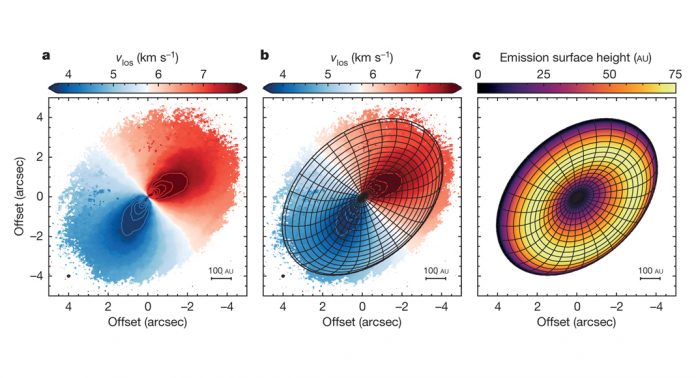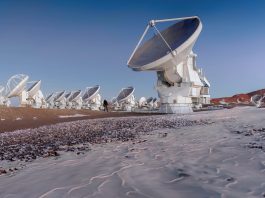Professor Edwin Bergin from the University of Michigan’s Department of Astronomy explains why a better understanding of water in space is crucial in understanding how planets are formed – including our own – and how this will be better achieved with the forthcoming generation of new observatories and telescopes.
Today, we have confirmed more than 4,000 planets orbiting stars beyond our own, and we are on the cusp of the search for signatures of life in the atmospheres of Earth analogues. Amongst the myriad of questions engendered by this expanding landscape is: how did these planets come to be, and what are the conditions needed for life to present? Here, of course, the focus lies on the one world in the vastness of space that we know has life present: Earth. The focus of my research is in understanding how planets like our own are born. How did a rocky world form with life’s essential materials present on its surface (water and organics)?
From our own solar system, we know that this is not preordained, so something about the Earth’s formation is key towards fostering the development of life. To give some perspective, we think of the Earth as a water world, but that is an illusion. Water comprises only about 0.1% of the Earth’s mass (Meech and Raymond, 2020); we are a silicate rock in space with a tiny sprinkling of water. Astronomers think that the Earth’s lack of water is the direct result of planet formation and my work is focused broadly on how planets are born and following the trail of water during this process.
How do planets form?
Planets are born inside discs of gas and the tiny dust particles made of silicates and carbonaceous compounds that are coated with layers of mostly water ice. These tiny particles are the silicate seeds of Earth-like rocky worlds. Amazingly, before planets are born these seeds have initial sizes of only 0.1 microns – the Earth was initially 9×1041 minuscule pieces.
The solar system disc is generally called the ‘Solar Nebula’. Inside the Solar Nebula, these particles collide with each other and grow into millimetre- to centimetre-sized pebbles. These pebbles represent a crucial stage of planet formation as current theories suggest that initial growth to Mars-sized bodies in the inner solar system occurred via accretion of these tiny pebbles by larger bodies that initially formed under the influence of gravity (Johansen and Lambrechts, 2017). The Earth then formed as these large bodies gravitationally competed to gather up local material via a series of violent collisions (Meech and Raymond, 2020).
There are chemical consequences during planet formation as well. We know that material is hotter closer to the young Sun and colder far away – which makes sense. This matters, as ices are more volatile than the silicate seeds and sublimate (ice to gas transition) across distinct ‘icelines’. Based on our knowledge of water in the solar system, the iceline is found somewhere in the asteroid belt (Morbidelli et al., 2012). Solids that form well beyond the iceline contain at least 20% of ices (mostly water) by mass such as comets (Choukroun et al., 2020). The Earth formed inside its iceline, which accounts for its water-poor nature.
Tracing life’s ingredients in space
Regions of incipient planetary birth can be detected in space by looking at wavelengths longer than that of optical light, in the microwave-radio part of the spectrum. At these wavelengths, we observe the pebble-seeds of the Earth in space by the re-emission of stellar light. We can also observe molecules in the gas as they emit radiation at distinct frequencies and we ‘tune’ our telescopes to detect species such as water and carbon monoxide. What we can’t do, however, is directly detect young still-forming Earth-like planets – so we must characterise the building blocks while searching for more massive planets to trace in situ planet formation.
Today, the Atacama Large Millimeter Array (ALMA) represents a premier facility to observe these solids and trace planet formation. From current observations, we can measure the total mass of pre-planetary pebbles and find that it is below that of the mass of observed extrasolar planetary systems (Manara et al., 2018). This directly informs us that there must be many larger kilometre-sized bodies present (which are undetectable).
Observations of gaseous molecules trace the composition, but also probe the velocity field to search for hidden planets. In Fig. 1 above, we show the exquisite velocity field in the gaseous disc surrounding a nearby young star. The blue-red pattern is the motion of the gaseous disc orbiting the star as seen by the doppler effect.
From these, and similar observations, Richard Teague (Teague et al., 2019), along with Jaehan Bae, myself, and Christophe Pinte (Pinte et al., 2018), with an international team, inferred the presence of hidden young forming gas giants which alter the velocity field in minute but measurable ways. In all, what we are learning from ALMA is that planet formation happens early in the evolution. Within one to two million years of the disc forming, much of the material that made the Earth was initially assembled.
Looking to the future
This brings us to tracing Earth-like worlds. NASA is on the verge of launching the James Webb Space Telescope (JWST) and both the United States and Europe are building large >20 metre-sized optical telescopes. In the coming decade we can thus expect fantastic growth in the detection and characterisation of exoplanetary terrestrial planets. We will be on the hunt for life elsewhere. To fully interpret this wealth of data on exoplanet composition, we need to understand how the formation process itself leads to specific outcomes. To trace the formation of the Earth itself and determine the basic underpinning of life’s origins, the supply of life’s materials, we also need new facilities. Foremost among these proposed new observatories are the next generation Very Large Array (ngVLA) and the Origins Space Telescope.
The ngVLA builds upon an existing state-of-the-art observatory in New Mexico: the Jansky Very Large Array. As proposed, the ngVLA will have order of magnitude improvements in resolution and sensitivity on the existing array and be more sensitive than ALMA in certain key areas. To understand the full import, with today’s ALMA, we are able to peer about five to 10 astronomical units (au – Earth lies at one au) into the nearest region of incipient stellar birth. With the ngVLA, we will be able to probe the presence of planets down to 0.5 au and so resolve the formation of solar systems like our own. Furthermore, at these radii orbital timescales are measured in years rather than decades, like at 10 au. With the ngVLA, we will be able to watch these systems in motion, which is critical in terms of understanding the physics of planetary birth.
To fully understand the formation of the Earth, we also need to follow the water. Our current theories suggest that the Earth formed dry with little to no water vapour. Instead, water was supplied to it from greater distances beyond the iceline located in the asteroid belt. Bodies in the belt were gravitationally disturbed by interactions with Jupiter. Some had new orbits that intersected and collided with the still-forming Earth. Thus, impacts provided the Earth with needed water, but the presence of water inside these bodies was set by their formation near or beyond the Solar Nebula iceline (Bergin and Cleeves, 2018; Meech and Raymond, 2020). Because our own atmosphere contains water vapour (a good thing!), to readily observe water on other planets requires a space-based observatory. Origins represents a proposed mission concept that would be capable of following the trail of water and measuring the location of the iceline in over 1,000 disc systems. This will be done by Origins’ large spectral grasp that captures nearly the entire spectrum of water vapour (see Fig. 2). Each of these spectral lines originates from gas at specific temperatures, tracing both hot and cold water vapour. Using models, we can invert this and determine the physical distance of the iceline.
Why does this matter? Recall in astronomy that we can only observe objects generally in a snapshot of time as they evolve on millions of year timescales. To capture evolution, we observe many objects in different stages. Because of its spectral grasp and sensitivity, Origins can observe over 1,000 discs that will then probe iceline evolution during the main phase of planetary assembly while also measuring both the ice and the gaseous content. This is critical information for understanding the formation of our own planet.
By studying the birth of planets, astronomers seek a broad perspective of our own origins. With existing facilities such as ALMA and JWST, along with hoped-for proposed facilities (ngVLA and Origins), we are and will provide a treasure trove of missing information to enable scientists to piece together the puzzle of why we are here.
References
E A Bergin and L I Cleeves, 2018. ‘Chemistry During the Gas-Rich Stage of Planet Formation.’ Handbook of Exoplanets, Eds. H J Deeg and J A B Avilés (Springer, Dordrecht) (Univ. of Arizona Press, Tucson), 325.
M Choukroun and 11 colleagues, 2020. ‘Dust-to-Gas and Refractory-to-Ice Mass Ratios of Comet 67P/Churyumov-Gerasimenko from Rosetta Observations’. Space Science Reviews, 216.
A Johansen, M Lambrechts, 2017. ‘Forming Planets via Pebble Accretion’. Annual Review of Earth and Planetary Sciences, 45, 359–387.
C F Manara, A Morbidelli, T Guillot, 2018. ‘Why do protoplanetary discs appear not massive enough to form the known exoplanet population?’. Astronomy and Astrophysics, 618.
A Morbidelli, J I Lunine, D P O’Brien, S N Raymond, K J Walsh, 2012. ‘Building Terrestrial Planets’. Annual Review of Earth and Planetary Sciences, 40, 251–275.
C Pinte, D J Price, F Ménard, G Duchêne, W R F Dent, T Hill, I De Gregorio-Monsalvo, A Hales, D Mentiplay, 2018, ‘Kinematic Evidence for an Embedded Protoplanet in a Circumstellar Disc’. The Astrophysical Journal, 860, L13.
R Teague, J Bae, E A Bergin, 2019. ‘Meridional flows in the disc around a young star’. Nature, 574, 378–381.
Edwin (Ted) Bergin
Professor and Chair of Astronomy
Department of Astronomy
University of Michigan
+1 734 764 3441
ebergin@umich.edu
Tweet @michiganastro
https://lsa.umich.edu/astro
www.facebook.com/MichiganAstronomy









